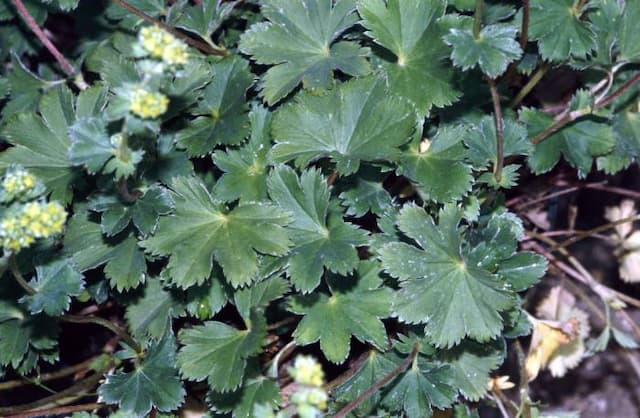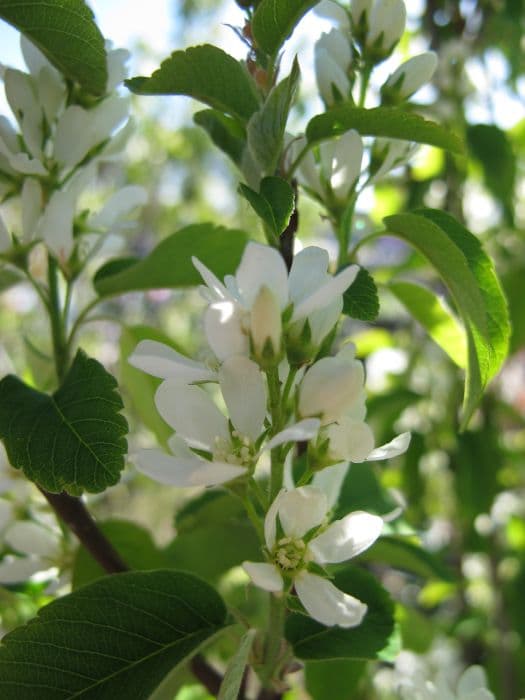Snowy Mespilus Amelanchier laevis 'Snow Cloud'

ABOUT
The plant known as 'Snow Cloud', a variety of serviceberry, is characterized by its striking multi-seasonal interest. During spring, it showcases a profusion of white flowers that cover the branches, creating a cloud-like effect that is both elegant and eye-catching. Following the floral display, the plant produces small, round berries that transition from red to dark purple as they ripen, often attracting birds and other wildlife. The foliage of the 'Snow Cloud' serviceberry is equally attractive, with leaves that are oval to oblong in shape and possessing a smooth edge. They emerge as a coppery color, then turn to a lush green as they mature. When autumn arrives, the leaves transform again, this time into brilliant shades of orange and red, providing a spectacular fall color display. The bark is smooth and gray, adding a sophisticated texture to the plant's overall appearance. The structure of the serviceberry is typically multi-stemmed, with an upright and slightly rounded form that gives it an elegant presence in the landscape. The overall aesthetic of 'Snow Cloud' serviceberry is one of graceful beauty, with its combination of flowers, fruit, foliage, and bark, providing year-round interest and making it a standout plant in any garden setting.
About this plant
 Names
NamesFamily
Rosaceae
Synonyms
Allegheny Serviceberry, Smooth Shadbush, Smooth Serviceberry, Snow Cloud Serviceberry
Common names
Amelanchier laevis 'Snow Cloud'.
 Toxicity
ToxicityTo humans
Serviceberry, including the cultivar Amelanchier laevis 'Snow Cloud', is not known to be toxic to humans. In fact, the berries are edible and often used in jams, jellies, and pies. There is no commonly reported toxicity from ingesting any part of the serviceberry plant.
To pets
Serviceberry, including the cultivar Amelanchier laevis 'Snow Cloud', is not known to be toxic to pets. The berries and plant parts are not commonly considered poisonous, and there are no commonly reported symptoms of poisoning in pets resulting from ingesting serviceberry.
 Characteristics
CharacteristicsLife cycle
Perennials
Foliage type
Deciduous
Color of leaves
Green
Flower color
White
Height
15-25 feet (4.5-7.6 meters)
Spread
15-25 feet (4.5-7.6 meters)
Plant type
Tree
Hardiness zones
4-9
Native area
North America
Benefits
 General Benefits
General Benefits- Ornamental Value: Offers stunning white flowers in spring, enhancing the aesthetics of gardens and landscapes.
- Attracts Wildlife: Provides food in the form of fruits for birds and habitat for various wildlife.
- Four-Season Interest: Features spring blooms, summer fruits, vibrant fall foliage, and a striking winter silhouette.
- Easy to Grow: Requires low maintenance and is adaptable to various soil conditions.
- Drought Tolerance: Once established, has the capacity to withstand periods of dryness.
- Fall Foliage: Produces striking autumn colors, adding visual interest to the fall landscape.
- Edible Fruit: Produces small pomes that are edible and can be used in jellies and pies.
 Medical Properties
Medical PropertiesThis plant is not used for medical purposes.
 Air-purifying Qualities
Air-purifying QualitiesThis plant is not specifically known for air purifying qualities.
 Other Uses
Other Uses- Wildlife habitat: 'Snow Cloud' provides cover and nesting sites for birds and other small wildlife.
- Photography: Its attractive blooms and form make it a good subject for nature and landscape photography.
- Bonsai: Some gardeners may use 'Snow Cloud' in bonsai due to its small leaves and potential for attractive branching patterns.
- Culinary decoration: The edible berries can be used as a decorative garnish on desserts and other dishes.
- Ink and dye: The tannins present in the bark and fruit can be used for making natural dyes or ink.
- Educational use: 'Snow Cloud' can be used in school projects or educational gardens to teach about native plants and pollination.
- Winter interest: The plant's structure and berries offer visual interest in gardens during the dormant season.
- Woodworking: Although not a large tree, the wood from 'Snow Cloud' can be used for small woodworking projects like carving or turning.
- Artistic inspiration: Artists may draw, paint, or otherwise use 'Snow Cloud' as a model for artistic projects due to its aesthetic appeal.
- Screening: 'Snow Cloud' can be planted in groups to create privacy screens in residential gardens.
Interesting Facts
 Feng Shui
Feng ShuiThe Serviceberry is not used in Feng Shui practice.
 Zodiac Sign Compitability
Zodiac Sign CompitabilityThe Serviceberry is not used in astrology practice.
 Plant Symbolism
Plant Symbolism- Renewal: Commonly known as Allegheny serviceberry, this plant often signals the arrival of spring with its early blooms, representing a fresh start or awakening.
- Hope: The white blossoms of Allegheny serviceberry can symbolize hope, as its flowering can herald the end of the dark, cold winter months.
- Innocence: White flowers are often associated with purity and innocence, and the Allegheny serviceberry's delicate white blossoms can carry this symbolism.
- Purpose: Native Americans used the serviceberry for a variety of practical uses, including its fruit for food and its wood for making tools, signifying usefulness and purpose.
 Water
WaterThe Allegheny serviceberry or 'Snow Cloud' prefers even moisture and should be watered deeply once a week, providing about 1 to 1.5 gallons of water each time, depending on soil conditions and climate. In periods of drought or extreme heat, increase watering frequency to twice a week. Newly planted trees require more frequent watering, about twice a week, until they establish. During the winter, reduce the water to when the soil is dry to the touch, as the plant is dormant and requires less moisture. Ensure that water penetrates the soil to the root zone and avoid shallow sprinkling, as it encourages weak root growth.
 Light
LightThe Allegheny serviceberry thrives in full sunlight to partial shade. The ideal spot for this plant would be an area where it receives at least 4 to 6 hours of direct sunlight each day, coupled with some afternoon shade, especially in regions with very hot summers. Understory positions with dappled sunlight throughout the day also simulate its natural woodland habitat.
 Temperature
TemperatureThe Allegheny serviceberry can tolerate a wide range of temperatures, making it a versatile plant for many climates. It can survive winter lows down to around -20°F and is comfortable during the summer temperatures up to 90°F. The ideal growing temperature for this plant would be between 60°F and 80°F, which typically promotes the best flowering and fruiting results.
 Pruning
PruningPrune the Allegheny serviceberry to maintain its shape and encourage healthy growth, ideally during late winter or early spring before new growth starts. Remove any dead, damaged, or diseased wood, as well as any crossing or rubbing branches. Thinning out the canopy can also improve air circulation. Pruning can be done annually, keeping in mind that flowering occurs on old wood, so pruning should be done with care to not remove too many flower buds.
 Cleaning
CleaningAs needed
 Soil
SoilAllegheny serviceberry (Amelanchier laevis 'Snow Cloud') thrives best in a well-draining loamy soil, enriched with organic matter, such as compost or well-rotted manure. Aim for a soil pH between 6.0 and 7.5 for optimal growth. A balanced mix of sand, silt, and clay with organic amendments will support the health and vigor of the plant.
 Repotting
RepottingAllegheny serviceberry does not typically require repotting as it is most often grown outdoors as a landscape plant due to its size. If grown in a container, it should be repotted every 3-4 years to prevent root-bound conditions and to replenish nutrients in the soil.
 Humidity & Misting
Humidity & MistingAllegheny serviceberry does well in average outdoor humidity levels and does not have specific humidity requirements. It is adaptable to a wide range of humidity conditions found in its hardiness zones.
 Suitable locations
Suitable locationsIndoor
Not ideal indoors; requires full sun and space to grow.
Outdoor
Plant in well-draining soil, full sun to partial shade.
Hardiness zone
4-9 USDA.
 Life cycle
Life cycleAmelanchier laevis 'Snow Cloud', commonly known as Smooth Serviceberry or Allegheny Serviceberry, begins its life as a seed which, after a period of cold stratification, germinates in spring. The seedling then develops into a deciduous shrub or small tree, with rapid growth in its initial years until it reaches maturity. During early spring, mature plants produce white flowers that attract pollinators and give way to small, edible pome fruits that mature by summer. The fruits are dispersed by wildlife, facilitating the spread of the plant. In autumn, the leaves turn vibrant shades of yellow, orange, and red before falling off as the plant enters dormancy in winter. Over the years, the plant can form suckers, creating a clonal colony and extending its life cycle beyond the typical individual lifespan.
 Propogation
PropogationPropogation time
Spring-Early Summer
The Amelanchier laevis 'Snow Cloud', commonly known as Smooth Serviceberry or Snow Cloud Serviceberry, is a plant that can be propagated through various means, but the most popular method is by softwood cuttings. This technique is typically done in late spring or early summer, when new growth is still flexible but starting to mature. Cuttings should be taken from healthy branches, making sure each cutting is about 4 to 6 inches (10 to 15 centimeters) long with several leaves. The lower leaves are removed, and the cut end is often dipped in a rooting hormone to encourage root development. These prepared cuttings are then placed in a well-draining potting mix, ensuring high humidity and consistent moisture without being waterlogged. Roots generally develop in a few weeks, after which the new plants can be transplanted into individual pots or directly into the garden.









